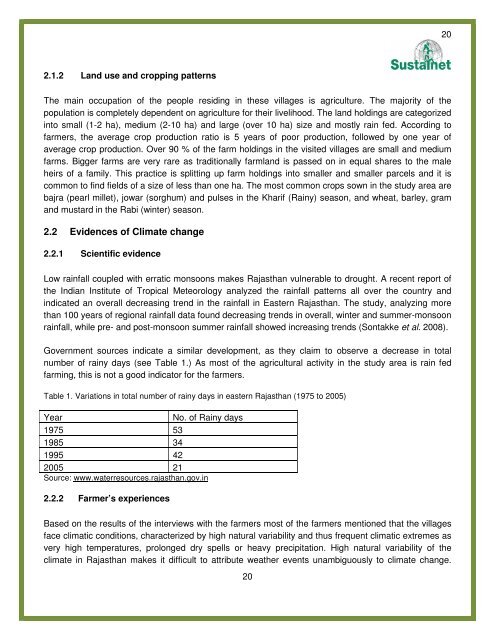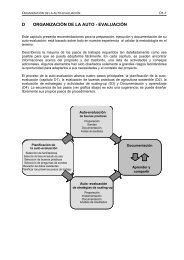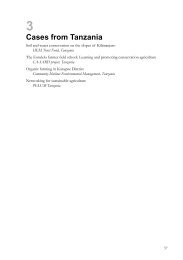Adaptation of small scale farmers to climatic risks in India - Sustainet
Adaptation of small scale farmers to climatic risks in India - Sustainet
Adaptation of small scale farmers to climatic risks in India - Sustainet
Create successful ePaper yourself
Turn your PDF publications into a flip-book with our unique Google optimized e-Paper software.
2.1.2 Land use and cropp<strong>in</strong>g patterns<br />
The ma<strong>in</strong> occupation <strong>of</strong> the people resid<strong>in</strong>g <strong>in</strong> these villages is agriculture. The majority <strong>of</strong> the<br />
population is completely dependent on agriculture for their livelihood. The land hold<strong>in</strong>gs are categorized<br />
<strong>in</strong><strong>to</strong> <strong>small</strong> (1-2 ha), medium (2-10 ha) and large (over 10 ha) size and mostly ra<strong>in</strong> fed. Accord<strong>in</strong>g <strong>to</strong><br />
<strong>farmers</strong>, the average crop production ratio is 5 years <strong>of</strong> poor production, followed by one year <strong>of</strong><br />
average crop production. Over 90 % <strong>of</strong> the farm hold<strong>in</strong>gs <strong>in</strong> the visited villages are <strong>small</strong> and medium<br />
farms. Bigger farms are very rare as traditionally farmland is passed on <strong>in</strong> equal shares <strong>to</strong> the male<br />
heirs <strong>of</strong> a family. This practice is splitt<strong>in</strong>g up farm hold<strong>in</strong>gs <strong>in</strong><strong>to</strong> <strong>small</strong>er and <strong>small</strong>er parcels and it is<br />
common <strong>to</strong> f<strong>in</strong>d fields <strong>of</strong> a size <strong>of</strong> less than one ha. The most common crops sown <strong>in</strong> the study area are<br />
bajra (pearl millet), jowar (sorghum) and pulses <strong>in</strong> the Kharif (Ra<strong>in</strong>y) season, and wheat, barley, gram<br />
and mustard <strong>in</strong> the Rabi (w<strong>in</strong>ter) season.<br />
2.2 Evidences <strong>of</strong> Climate change<br />
2.2.1 Scientific evidence<br />
Low ra<strong>in</strong>fall coupled with erratic monsoons makes Rajasthan vulnerable <strong>to</strong> drought. A recent report <strong>of</strong><br />
the <strong>India</strong>n Institute <strong>of</strong> Tropical Meteorology analyzed the ra<strong>in</strong>fall patterns all over the country and<br />
<strong>in</strong>dicated an overall decreas<strong>in</strong>g trend <strong>in</strong> the ra<strong>in</strong>fall <strong>in</strong> Eastern Rajasthan. The study, analyz<strong>in</strong>g more<br />
than 100 years <strong>of</strong> regional ra<strong>in</strong>fall data found decreas<strong>in</strong>g trends <strong>in</strong> overall, w<strong>in</strong>ter and summer-monsoon<br />
ra<strong>in</strong>fall, while pre- and post-monsoon summer ra<strong>in</strong>fall showed <strong>in</strong>creas<strong>in</strong>g trends (Sontakke et al. 2008).<br />
Government sources <strong>in</strong>dicate a similar development, as they claim <strong>to</strong> observe a decrease <strong>in</strong> <strong>to</strong>tal<br />
number <strong>of</strong> ra<strong>in</strong>y days (see Table 1.) As most <strong>of</strong> the agricultural activity <strong>in</strong> the study area is ra<strong>in</strong> fed<br />
farm<strong>in</strong>g, this is not a good <strong>in</strong>dica<strong>to</strong>r for the <strong>farmers</strong>.<br />
Table 1. Variations <strong>in</strong> <strong>to</strong>tal number <strong>of</strong> ra<strong>in</strong>y days <strong>in</strong> eastern Rajasthan (1975 <strong>to</strong> 2005)<br />
Year No. <strong>of</strong> Ra<strong>in</strong>y days<br />
1975 53<br />
1985 34<br />
1995 42<br />
2005 21<br />
Source: www.waterresources.rajasthan.gov.<strong>in</strong><br />
2.2.2 Farmer’s experiences<br />
Based on the results <strong>of</strong> the <strong>in</strong>terviews with the <strong>farmers</strong> most <strong>of</strong> the <strong>farmers</strong> mentioned that the villages<br />
face <strong>climatic</strong> conditions, characterized by high natural variability and thus frequent <strong>climatic</strong> extremes as<br />
very high temperatures, prolonged dry spells or heavy precipitation. High natural variability <strong>of</strong> the<br />
climate <strong>in</strong> Rajasthan makes it difficult <strong>to</strong> attribute weather events unambiguously <strong>to</strong> climate change.<br />
20<br />
20




